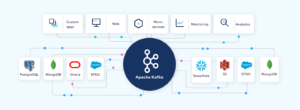Introduction
Kafka is an open-source software platform developed by LinkedIn to handle real-time data. Kafka is a distributed streaming platform that can process, as well as transmit, messages in real-time. While stream processing and microservices are where Apache Kafka is most commonly was using, it also has a wide range of additional applications.
Kafka is a distributed publish-subscribe messaging system that supports flexible partitioning and replication of messages among nodes in a cluster. Kafka also provides the ability to query data stored in its message logs using tools such as KSQL or Spark SQL, allowing developers to easily consume large amounts of data without having to write their own custom code or libraries for parsing this information into something useful.
Get to know about it –
Kafka has a high-throughput and low-latency platform.
Kafka can handle millions of messages per second, tens of thousands of writes per second and hundreds of reads per second. The platform is designed to be highly scalable and fault tolerant. This makes it ideal for applications that require high-throughput and low-latency processing capabilities.
It is used to handling real-time data pipelines. The messaging system supports batch- and event-driven processing. Kafka’s architecture makes it ideal for streaming applications because it provides the high throughput, low latency, and fault tolerance of a cluster with the scalability of a single node.
Where does Kafka fit in?

How does it Work so Easily?
Kafka allows high volume/velocity data streams in real time or near real time (NRT) to evolve analytics at scale without compromising performance or latency requirements, such as delivering alerts on events occurring within microseconds of their occurrence – allowing users to respond rapidly without waiting days or weeks until findings are back from slower databases like Oracle etc.,
Kafka can process, as well as transmit, messages in real-time. The platform’s design allows it to process large amounts of data quickly and with little latency.
Apache Kafka is written in Scala and Java.
Odersky developed Scala, a general-purpose programming language, at EPFL in 2004. Scala has since become one of the most popular languages for building concurrent applications.
Sun Microsystems developed Java around 1995 as an object-oriented extension to the C++ programming language that allows you to create applications using Java bytecode (bytecode being what your computer understands but cannot execute on its own). A lot more people use Java today than Scala, but there are plenty who prefer it to other languages such as Python or Ruby because they feel it’s easier to read and understand overall—even though this may be true only in certain situations where speed isn’t particularly important like small scripts or single-client web apps with simple requirements (like writing tweets or sending emails).
Apache Kafka runs on JVM (Java Virtual Machine).
It runs on JVM, which is a virtual machine that interprets and executes Java bytecode. JVM is a virtual machine that runs Java programs and is independent of a specific platform.
Who uses ?

Conclusion
It has a scalable architecture, high throughput, and low latency design. Kafka uses a distributed message broker to store and process data in real-time. It can serve as an intermediate layer between applications and databases or other services that demand fast performance but aren’t necessarily as large as MapReduce clusters on Google Cloud Platform.




